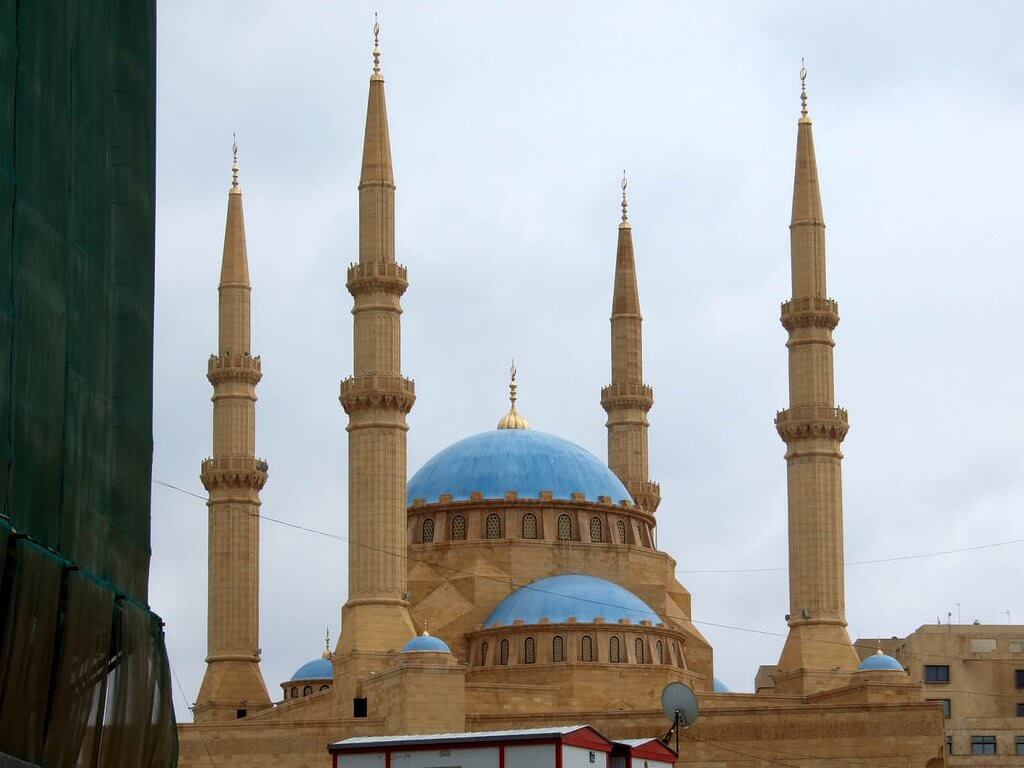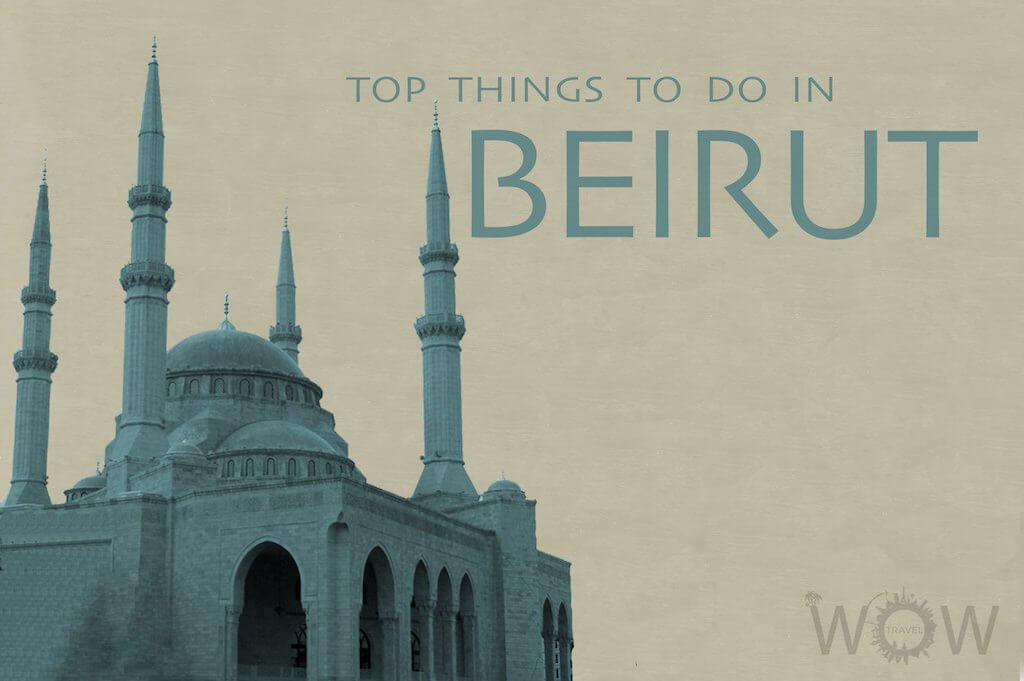Though this city has had a recently troubled past, the Lebanese capital, once known as the Paris of the East, is busy reinventing itself again. Beirut, the only true cosmopolitan city in Lebanon, is a great place to start if you’re traveling to the Middle East for the first time, as the city symbolizes the crossroads where East and West meet. Whether you want to sit by the Mediterranean sea, visit one of many museums, mosques or typical souks, Beirut has it all. Check out our Top 11 Things To Do In And Around Beirut.
[booking_product_helper shortname=”beirut”]
Al-Amin Mosque
1
Located in downtown Beirut, The Mohammad Al-Amin Mosque, also referred to as the Blue Mosque or Hariri’s Mosque. It is called the Hariri Mosque informally because its construction was financed by Rafiq Hariri, the Lebanese construction magnate cum President who was assassinated in 2005. The inspiration of Istanbul’s Blue Mosque is pretty clear in this place of worship as well, which was completed between 2002 and 2007.

Saint George Maronite Cathedral
2
Saint. George Cathedral is a neoclassical basilica that serves Lebanon’s Maronite Christian community. The church dates back to 12th century crusaders, but the modern iteration was built between 1884 and 1894 modeled after Santa Maria Maggiore in Rome. Some of the columns were recycled from Roman ruins elsewhere in Lebanon. During the civil war, the cathedral was badly damaged and looted. It took years to fully restore, and many stolen objects have since been returned.

Baalbek
3
3 hours drive from Beirut, Baalbek is a temple complex, a marvel of engineering and a monumental reminder of Rome’s former stranglehold on this region. It is the most spectacular archaeological site in Lebanon built by the Phoenicians and the Romans. The temple opens 7 days a week from 9 a.m. till 5 p.m. and is actually safe to be visited.

Place de l’Etoile
4
Place de l’Etoile is the central square in Downtown Beirut. It is one of the most popular places to enjoy the local atmosphere and soak in the local culture. It is famous for its architecture and has become a focal point and identity of the Beirut city. Enjoy the street life and dine in its numerous cafes while one just can not miss its Ottoman structure in stone and marble. The jewel of the square is a 1930s clock-tower with its four-faced Rolex clock. The clock tower was presented to the city by its mayor during the French Mandate era. Today, the square is filled with tourists and locals who come here to dine, walk or enjoy the street life. The square is also known for its noticeable population of pigeons. Source: ixigo


Beirut Souks & Souk el Tayeb
5
Beirut Souks is a great place to relax from Beirut’s Traffic. You can find everything there including coffee shops, restaurants, a supermarket, designer shops and even a cinema. Every Saturday morning there is farmers market called Souk el Tayeb, the market hosts over 60 producers from all over Lebanon who sell various food products (Fruits, Vegetables, Mouneh, Lebanese dishes, Honey, Olive and Oil, Pastries, Saj, Sweets and Marzipan) as well as traditional and special handmade crafts (Kids books, soap, glass and pottery).

Corniche
6
The 10 km (6.2 miles) long al-Manara Corniche, the seafront promenade named after the lighthouse, is lined with palm trees. Small vendors are selling coffee, tea and snacks. The Corniche lends itself to watching the sunset while leaning on the banister and enjoying the sound of the sea. On summer days, the rocks below are full of sunbathing and swimming boys and men. South of the Corniche is Raouche, mostly famous for its Pigeon Rocks, a 60 meter (196 ft) high offshore rock couple, which was formed in the prehistoric era by a geologic movement. Source: living-lebanon

Raouche (Pigeon Rocks)
7
South of the Corniche is Raouche, mostly famous for its Pigeon Rocks, a 60 meter (196 ft) high offshore rock couple, which was formed in the prehistoric era by a geologic movement. Pigeon Rocks is where Beirut’s teenagers go for assignations, and tourists go to watch and wonder.

Place des Martyrs
8
The Place Des Martyrs, in the center of Beirut, is a natural pivot between the predominantly Muslim west and Christian east. Martyrs’ Square is a tribute to the martyrs of Lebanon, and it has a long history as a site of protests and demonstrations.

Roman Baths
9
In the middle of downtown Beirut are remains of the Roman Baths which once served the city’s population. Originally discovered in 1968-69, it underwent a thorough cleaning and further excavation in 1995-1997. The history behind the baths is simply breathtaking.

Byblos
10
Located 40 minutes ride from Beirut, Byblos is one of the most beautiful places in Lebanon and one of the oldests in the world. It is where The alphabet was created. The city’s key tourist sites include ancient Phoenician temples, Byblos Castle, St John the Baptist Church and the old Medieval City Wall.

Jeita Grotto
11
The Jeita Grotto, the longest cave in the Middle East, is situated approximately 18km (11 miles) north of Beirut. It is a system of two separate, but interconnected, karstic limestone caves. One of the worlds most amazing agglomerations of stalactites and stalagmites, Jeita Grotto is widely considered to be the pride of Lebanon, and featured as a finalist in the New 7 Wonders of Nature competition.

Just So You Know…
- 40% of the Lebanese people are Christians, this is the highest percentage of all the Arab countries.
- Beirut was destroyed and rebuilt 7 times, this is why it’s compared to The Phoenix.
- The first law school in the world was built in Beirut.
- Beirut’s nightlife will leave you speechless, it is the party capital of the Middle East. There are so many clubs and bars to check out. Just wander around one of these streets: Gemmayze Street, Mar Mikhael Street, Monnot Street, Uruguay Street, Hamra Street and Jounieh Old Souk.
- WalkBeirut offers the only extensive, in-depth guided walking tour of Beirut. Tours are offered in English by graduates in history from the American University of Beirut.
- Around 25 miles south of Beirut lies Sidon, one of the most important – and perhaps the oldest – Phoenician cities. It was the base from which the Phoenician’s great Mediterranean empire grew. Both Jesus and St Paul are said to have visited Sidon, as did Alexander the Great, who captured the city in 333 BC. Source: telegraph
- Watch a horse racing at The Beirut Hippodrome, also called Hippodrome Du Parc De Betroth.
- Take a tour with Beirut Bites – a unique opportunity to get to grips with Lebanese food at it’s most raw (sometimes quite literally), avoiding places where tourists abound and, instead, taking you to places that only locals frequent. On this charming meander through the city, you’ll experience a variety of foods, from traditional mezze platters, Armenian bistros, to offal sandwiches (testicle kebabs anyone?), with plenty of options for the vegetarian as well.
Get Some Culture:
- Beirut National Museum – Discover the string of civilisations who’ve ruled Lebanon over the years.
- Robert Mouawad Museum – Portrays the vision and mirrors the appreciation bestowed by Henri Pharaon on his tenderly crafted collection.
- National Archaeological Museum – Includes an extensive collection of 100,000 objects, most of which are antiquities and medieval finds from excavations undertaken by the Directorate General of Antiquities.
- Sursock Museum – A facinating modern and contemporary art museum.
- MIM Museum – More than 1400 minerals are exhibited there, representing more than 300 different species from over 60 countries.
Favorite Night Clubs:
- Posh – One of Lebanon’s leading & most exclusive night clubs specializing in international & Arabic music; latest in lighting & laser shows.
- White Beirut – The ultimate chic playground for upscale party-goers. This rooftop hotspot offers delicious cocktails and live sets from DJs and performers from around the world.
- B018 – Beirut’s most legendary club, located in a part of the city that was a refugee camp during the civil war and the scene of some violence. B018 is shaped like a coffin, and looks like an old bomb shelter, but under what looks like a gloomy parking lot, lays a glamorous nightclub.
Grab A Bite:
- Karam – in the heart of Beirut, it offers exquisite delicious lebanese dishes in a perfect frame.
- Al Balad – Lebanese dining in a casual atmosphere, combines fusion cuisine, a charming setting and convivial staff.
- Gilt – A cool and modern restaurant. Serves interesting dishes presented in a very artful way.
